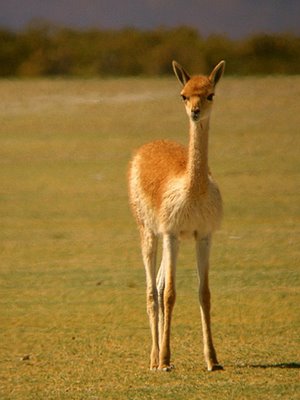 ~Vicuna, northwest Argentina. Photo by Nick Athanas, www.tropicalbirding.com
~Vicuna, northwest Argentina. Photo by Nick Athanas, www.tropicalbirding.com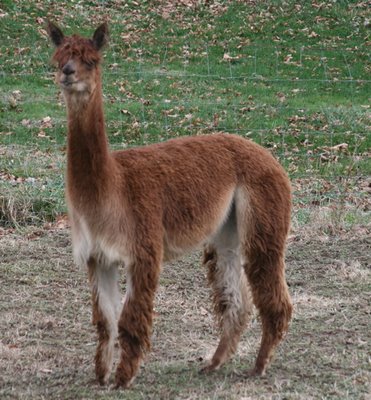 This alpaca looks a lot like a wild vicuna in coloration. I'd love to have her waistline.
This alpaca looks a lot like a wild vicuna in coloration. I'd love to have her waistline.Though they're sometimes confused with llamas, alpacas are much smaller (about 3' at the shoulder) and lighter of build. There are no wild alpacas; they have been bred as domestic animals for thousands of years. Their fiber is much finer than that of llamas or sheep, for that matter. Ann, proprietress of Riverboat Alpacas, explained to me that all alpaca and sheep fiber has little scales that stick up off of it. It's those scales that give us the perception of scratchiness. The scale height (the amount it sticks up off the fiber shaft) determines its scratchiness. Wool scales stick up .08 microns off the shaft. Alpaca scales stick up only .04 microns. And a micron is 1/25,000 of an inch.
The higher those scales stick up off the fiber, the scratchier the fiber. But the more closely those scales are packed, the smoother the fiber feels. Mohair wool has 6-8 scales per 100-micron length, while alpaca fiber has more than 9 scales per 100-micron length.
Another determining factor in the fineness of the fiber is the mean diameter of a sample of fibers. Again, this diameter is measured in microns. Let's start with human hair, which is between 40-80 microns in diameter, sometimes as high as 100 microns. Strong fiber, as is found in Navajo wool rugs, is 30 or more microns in diameter. You do not want to wear a fiber that coarse. Hair shirt, and all that. A medium fiber is from 25-29.9 microns in diameter. Fine fiber is 10-24.9 microns. Superfine/Baby alpaca fiber is 18-20 microns. And Royal fiber is less than 18 microns in diameter. So really good alpaca fiber is very thin, and has lots of very low-profile scales sticking up off it. It's also strangely and delightfully lustrous, even shiny.
And I'm sorry, but I don't want wool against my skin at all. But alpaca...now, that's another story. Alpaca fleece, besides being light and floaty and incredibly warm (3-4 times warmer than wool!) is virtually lanolin-free, which means it's hypoallergenic. The first thing I did while shopping was bury my nose in the fabulous alpaca teddy bear's fur and wait to see if it bothered me. Nope. I can't say the same about wool or rabbit fur.
The alpacas on Riverboat Ranch are almost all suri's. This is a variety of alpaca with long, silky hair with a high sheen. They have one gelded male who is of the huacaya variety. Their fleece is crimped, like a sheep's, and stands up in a thick, lush pile.
Because suri fiber is of higher quality, alpaca breeders don't intentionally breed suris and huacayas together. (Which is why Riverboat's lone huacaya male is gelded.) Suris are rare in Peru, and it's thought that they might suffer more from the cold there, because their silky hair does not offer as good insulation as does the fluffier huacayas'. They are rapidly gaining popularity in the US, however, and breeders are concentrating on expanding the range of colors in the suri line. In Peru, breeders prefer white animals, because they dye most of their fleece. In the States, people favor natural-colored blankets, hats, scarves and sweaters, so there's heavier selection for beautiful natural fleece colors.
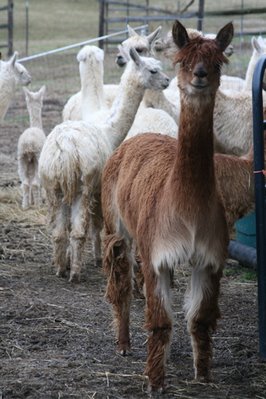 Check out this incredible autumn auburn.
Check out this incredible autumn auburn.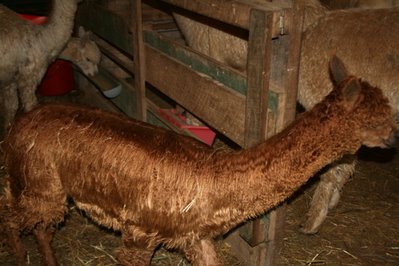 Look at the sheen on that hair! I don't think Annie uses Pantene "Liso y Sedoso" conditioner on her alpacas, but you'd think so. I'd like to get a shot of my Phoebe standing next to this beauty. Alpaca fanciers refer to this kind of fleece as "greasy." Gotta love it.
Look at the sheen on that hair! I don't think Annie uses Pantene "Liso y Sedoso" conditioner on her alpacas, but you'd think so. I'd like to get a shot of my Phoebe standing next to this beauty. Alpaca fanciers refer to this kind of fleece as "greasy." Gotta love it.Desperado, one of Ann and Charlie's first-acquired alpacas, is a black herd sire. They have a gorgeous maroon female, some caramel colored ones, mahogany, and, through breeding to a gray sire called Gunsmoke, they're shooting for a gray this coming spring.
Ann and Charlie's best alpaca is Sir Wilfred, an Accoyo suri, named for a Peruvian ranch where line breeding (breeding granddaughters to grandfathers and the like) developed animals with exceptionally fine fiber and what alpaca ranchers refer to as "good coverage," meaning lots of fiber all over the body, even the legs. There's deeply wrinkled skin under that hair, which means, I'm guessing, that there's more surface area for fleece to grow on. I saw one alpaca whose legs had been shorn, and was amazed at its deeply corrugated skin. I didn't photograph it, thinking it might have been a problem, but further reading told me alpaca breeders want them wrinkly! I'll have to go back and try to get a shot of that.
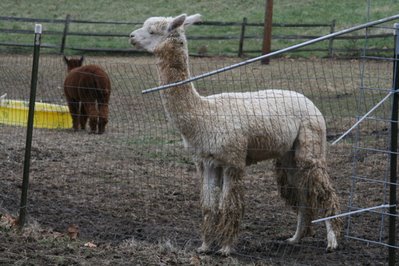 This is Sir Wilfred, the Accoyo suri stud. (There are also Accoyo huacayas). If I'm not mistaken, that chestnut animal in the background is a huacaya. See how wooly he looks, in comparison to the silky suri in the foreground? Want to breed your female alpaca to noble Sir Wilfred? Got $1500 lying around?
This is Sir Wilfred, the Accoyo suri stud. (There are also Accoyo huacayas). If I'm not mistaken, that chestnut animal in the background is a huacaya. See how wooly he looks, in comparison to the silky suri in the foreground? Want to breed your female alpaca to noble Sir Wilfred? Got $1500 lying around?One really interesting aspect of alpaca biology is that their fleece gets thicker in diameter each year, as they age. Thinner fleece: better, softer. Thicker, not as desirable. Alpacas can live to 20; the oldest known, Vomiting Violet, died at 29 on her ranch in New Zealand. Pregnant females have finer fiber than ones which aren't pregnant, so alpacas are bred each year. I remember my best hair days happened when I was pregnant, too.
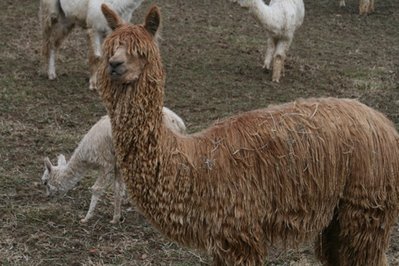
Wonder how many ounces of fiber this gal is carrying? Hope she's got a cria (baby alpaca) in there, too! So: Are you in love with alpacas yet? I am!






14 comments:
Sooooo many possible Tom and Katie jokes in this one ... but just too much good information to make fun of it!
Yep, in love.
I wonder if the wrinkly skin is desirable because it yields more fiber than smooth skin?
They must be charming animals, I'd love to go back to farming and raise alpacas....maybe in my next life.
Thanks for explaining where alpacas fit in the llama-vicuna context. Alpacas are so much cuter and sweeter than lllamas, which truth be told, can get downright nasty.
My boss has alpacas - about 5 or 6, I think - and has taken a class to learn how to spin their fiber; bought a spinning wheel, the whole bit.
Alpacas are really prone to heat stroke (you may be talking about this later, so sorry if I steal your thunder, Ms. Ant-blogger) and the first time I handled one was the first summer she had hers. You should have seen the two of us, trying to figure out how to restrain and treat this critter without stressing it out even more. When we were done, I said, "We need a textbook on alpacas before we go through that again!"
Waiting for more purty pictures, especially of some crias. (Ain't nuthin' cuter than a baby alpaca!)
~Kathi
I am! I am! From someone who has never allowed wool against my skin (not even a blend), I'd be in Alpaca heaven for its softness. They look huggable and *kissable* - which reminds me - goat cheese - hmmm.
We have a lot of alpacas here on little farms, once I was observing an eagles nest standing in a field of tall grass and got chased the heck out of there by an angry alpaca..perhaps he just wanted to play???
Little Orange Guy:
I've got it. Accoyo Huacaya Lopez- Anthony. Arriba!!
Susan Gets:
I'm thinking that's it, too, more surface area for hair follicles. As you'll see in subsequent posts--with alpaca farming, it's all about the fiber, the amount and the quality.
Julie, Did you hear them hum?? (or is that in a future post too?)
N with a tilde? Easiest thing in the world: ñ
but I kid. More here
When I guide trips in Colorado I noticed on TV there are commericals advertising how wonderful and profitable it is to raise alpacas. I don't understand the raising of aplacas but it must be making some money for a few people who raise alpacas.
Well, lookie there, Julie! Your very own BJSEEK.
Everyone should be that lucky.
BTW: That NBB is SUCH a showoff.
Julie, Thanks for showing so many folks a window into the alpaca world and for showing me what "blogging" is all about. Charlie and I love Allie pics!
Post a Comment